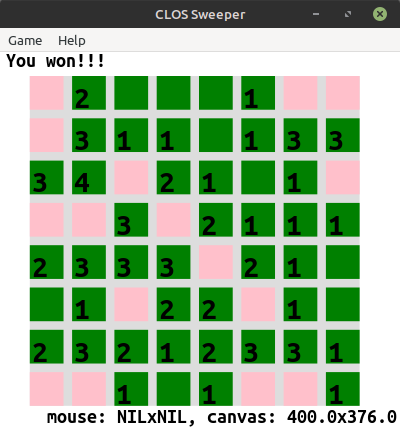A toy mine sweeper written in Common Lisp. Left mouse click uncovers the boxes. Right mouse click toggles the mine state. There are two different colours for right clicked boxes. Pink if there is a mine in that field and purple for flagged field without mine. This makes it helpful to solve even the large grid.
I can not find the way to create a small zipped folder to distribute Windows executable. If you happen to know how to do it please provide advice.
Public Domain
https://github.com/bohonghuang/cl-gtk4
https://lispcookbook.github.io/cl-cookbook/clos.html
Make sure SBCL is installed
Make sure you have quicklisp and ultralisp installed.
https://www.quicklisp.org/beta/
Make sure you have gtk4 libraries installed.
On Ubuntu like Linux you run:
sudo apt install libgtk-4-dev
First I installed Emacs from using the installer from https://www.gnu.org/software/emacs/download.html#nonfree
Then I installed SBCL 2.3.2 http://www.sbcl.org/platform-table.html
Then I installed MSYS2 https://www.msys2.org/
On Windows 11 with MSYS2 run MINGW64 terminal and execute:
pacman -S mingw-w64-x86_64-gcc mingw-w64-x86_64-gtk4 mingw-w64-x86_64-cairo mingw-w64-x86_64-gobject-introspection
I have a *.cmd c=script that starts Emacs with correct environment setting
set PATH=c:/msys64/mingw64/bin;c:/msys64/usr/bin;%PATH% C:\"Program Files"\Emacs\emacs-29.1\bin\runemacs.exe
Also I have a similar powershell_launcher.cmd that starts Windows powershell and allows me to run the tests and compile the executable from the shell
set PATH=c:/msys64/mingw64/bin;c:/msys64/usr/bin;%PATH% powershell
Use the cd command to go to the root of the project and run:
sbcl --load ./launch.lisp
(push #p"c:/Users/jacek/Programming/Lisp/clos-sweeper/" asdf:*central-registry*) (ql:quickload :clos-sweeper) (clos-sweeper::main)
(push #p"~/Programming/Lisp/clos-sweeper/" asdf:*central-registry*) (ql:quickload :clos-sweeper) (clos-sweeper::main)
sbcl --load ~/Programming/Lisp/clos-sweeper/testing.lisp
(push #p"~/Programming/Lisp/clos-sweeper/" asdf:*central-registry*)
(ql:quickload :clos-sweeper)
(ql:quickload :clos-sweeper/tests)
(asdf:test-system :clos-sweeper/tests)Some tests may write a snapshot of the canvas. It goes to tmp on Linux
and on Windows it goes to: C:\Users\jacek\AppData\Local\Temp.
That folder does not get cleared on reboot as tmp on Linux.
You have to clear the *.png files manually.
(ql:quickload :sblint) (sblint/run-lint:run-lint-asd "~/Programming/Lisp/clos-sweeper/clos-sweeper.asd" )
No icons yet, the state of the game is indicated by colour of the tiles.
I am not sure if roswell will be needed, but I will add the notes just in case we need it later.
https://github.com/roswell/roswell/wiki/Installation#windows
# Windows pacman -S mingw-w64-x86_64-roswell # Linux sudo apt install roswell # show your default Lisp ros list installed
https://github.com/roswell/roswell/wiki
https://github.com/roswell/roswell/wiki/How-to-setup-a-lisp-dev-environment-on-windows-with-Roswell
This can generate an executable but for all our purposes the section Running at the top makes more sense.
rm .\src\clos-sweeper.exe sh .\builder.ros .\src\clos-sweeper.exe
I could tell the users to install MSYS2 and do some checks to see if MSYS2 is installed and in good condition.
That would allow us to avoid the super entangled mess of Windows distribution
The folder distributions/clos-sweeper-windows contains 2 ways of testing MSYS2
installation.
https://stackoverflow.com/questions/47438779/executing-a-script-in-msys2-mingw
Compile the Lisp executable on Windows. Create a cmd script that will add MSYS2 path and call the executable. Create a shortcut to the cmd script to launch the script and the Lisp executable. The shortcut Properties dialog has a Run field that can be used to run the cmd script window minimized.
